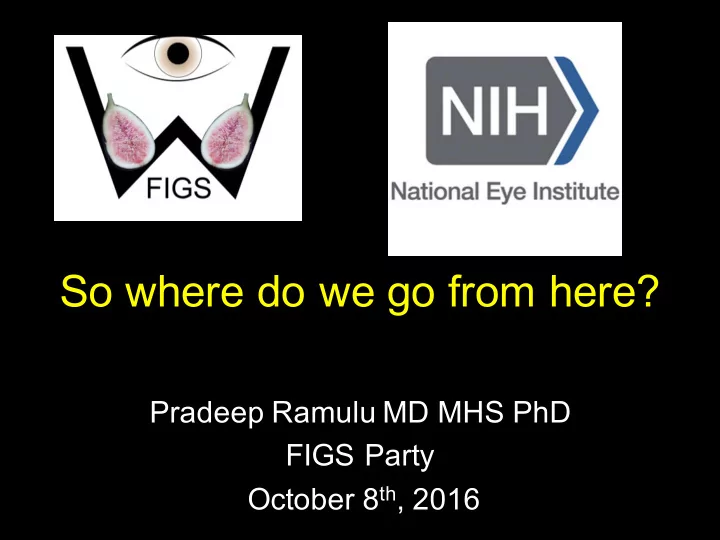

So where do we go from here? Pradeep Ramulu MD MHS PhD FIGS Party October 8 th , 2016
We now know risk factors which suggest a future fall Poor balance Gait parameters Specific areas of the home
What do we do with this information?
The future of home modification Currently few services to make the home safer Need for professional to visit home expensive and prohibitive However, home modification has been shown to reduce falls >50% of falls occur in / just outside home
Currently proposing: Methods to self-assess home Is it as good as a professional assessment? Can people self-modify their home for safety? Is this is as good as a profession doing it? Down the road: Can we turn this into a viable business model?
Other avenues to explore Balance & strength training programs to ↓ falls Can use relevant measures of balance & gait as surrogate measures to see if training likely to be effective Important to target persons at highest risk of falls Need to look at falls/steps taken, not falls/year
Direction #2: Might physical activity prevent vision loss? Mediation analyses Animal data Longitudinal studies
Accelerometers are the best way to measure real-world physical activity Calculate steps or minutes of moderate/ vigorous physical activity (MVPA) Reasonable correlation with gold-standard measurement of energy expenditure Much more related to BMI, triglycerides, blood glucose, skinfold thickness than self-reported activity
Large impact of visual field loss on physical activity Variable Interval RR, MVPA 95% CI Unilateral VF loss vs. normal sight 1.00 0.74 – 1.36 Bilateral VF loss vs. normal sight 0.70 0.52 – 0.94 Age 10 years older 0.72 0.68 – 0.75 Education No college 0.75 0.67 – 0.84 Arthritis vs. no arthritis 0.82 0.72 – 0.93 Diabetes vs. no diabetes 0.72 0.57 – 0.91 Cong heart failure vs. no CHF 0.57 0.37 – 0.90 Stroke vs. no stroke 0.55 0.36 – 0.86
Dose-response between VF loss severity & PA in glaucoma patients 15,000 Average Steps per Day 10,000 5,000 0
Fear of falling significantly higher in glaucoma patients ∆ Fear of falling p Variable Interval score (logits) value _ Glaucoma Present -1.20 0.001 VF Loss, better eye 5 dB worse -0.52 <0.001 Gender female -0.55 0.03 Comorbidities 1 illness -0.53 <0.001 Lives alone Yes +1.16 0.006 Other covariates: BMI, grip strength, age (all NS with p>0.05)
In glaucoma, physical activity does not seem the result of mobility problems Driving cessation -26% -22% VF loss, Physical 5 dB worse activity -30% Fear of falling
But In AMD patients, less physical activity is the result of mobility problems Fear of falling -11% Log CS, Physical 0.1 worse activity +2%
In mice, exercise can protect against age-related IOP damage to ERG Chrysostomou, Neurobiology of Aging 2014.
National Runner’s Health Study: fitness protective vs. glaucoma Glaucoma incidence decreased with running speed No new cases of glaucoma over 8 years in 781 men who ran 10k in under 34 minutes Williams, MSSE 2009; IOVS 2009
Will be proposing & testing: Are retinal vascular measures better amongst persons who are more active? Can these measures be improved with greater activity? Can greater activity prevent (or even reverse) glaucoma damage? What is the reason for such an association?
Recommend
More recommend